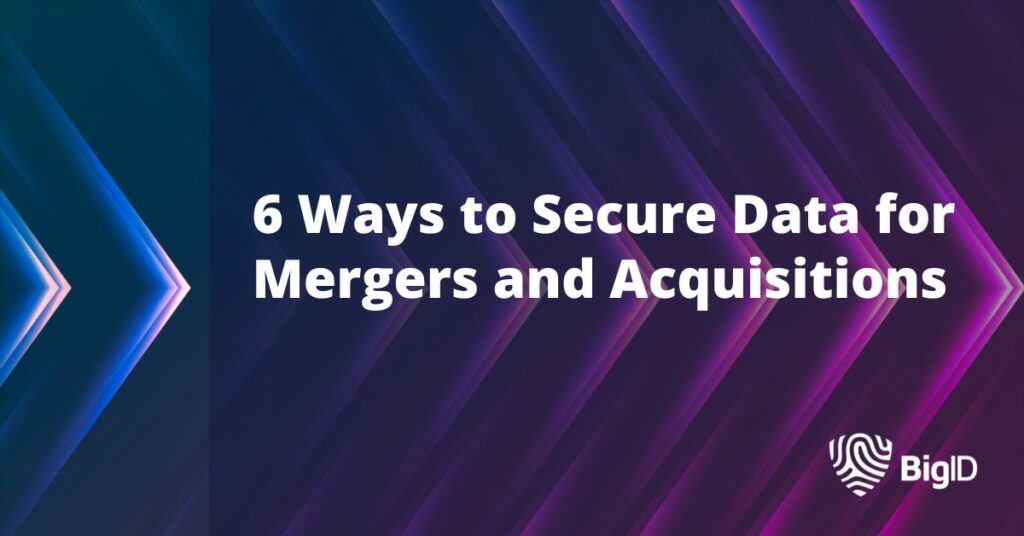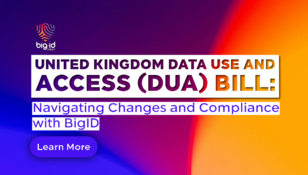6 Ways to Secure Data for Mergers and Acquisitions

Companies that are merging with another legal entity, acquiring an organization, or divesting of a business face one of the most complex operational and technological transactions they will likely encounter in the corporate lifecycle.
In This Article, Learn About:
- Due Diligence Challenges
- Integration Challenges
- How BigID Helps with Successful M&A
- Implement a Data-Centric M&A Strategy
While organizations are attracted to mergers and acquisitions (M&A) for various reasons — from expanding influence and competitive advantage to catapulting business growth — all the financial benefits in the world can’t make up for a haphazard M&A plan.
Less than one-third of acquisitions actually help companies grow faster than their historical rate, and poorly planned data integrations can turn a game-changing merger into a compliance and security debacle.
This article takes you through the best data integration practices for a successful M&A process so you can avoid common pitfalls, safeguard customer information, and know how to handle your data every step of the way. Learn how to implement a data-centric strategy that:
- automates deep data discovery and ML-based classification
- cleans up all your data
- reduces risk
- helps you achieve and maintain ongoing regulatory compliance
Due Diligence Challenges
At every phase of the M&A process — before, during, and after merger — IT teams are responsible for bringing two organizations’ data together into a new, secure, and reliable infrastructure that effectively:
- identifies and mitigates data risk
- supports consent governance
- maintains minimization requirements
- establishes ongoing accountability and reporting
Many challenges can arise. To begin with, even though more than half of all integration activities depend on IT — and IT is one of the most challenging areas to integrate — CIO and IT involvement is often delayed through the critical due diligence phase and only addressed during integration.
Due diligence is the stage to pinpoint data challenges that might surface. These include:
- identifying what data each company collects and holds
- classifying that data
- developing an integration plan
- ensuring that data is merged without duplication, disruption, or security breach
Involving CIOs early in the process opens up transparency around potential data migration issues and enables much-needed visibility into the systems and data being merged.
Integration Challenges
Merging companies need to share a multitude of data — from customers, employees, suppliers, vendors, and more. That data may come from legacy systems, multiple sources, and within both structured and unstructured data; may be sensitive, personal, or regulated; and likely involves some degree of redundancy.
Regulated data not only needs to be handled according to various policy requirements but must be integrated in the most secure way possible to enable proper governance and privacy compliance down the line.
How BigID Helps with Successful M&A
1. Discover and catalog all your data — everywhere
The challenge: Companies that are merging or acquiring enterprise data may exponentially increase the amount of data they process overnight. It’s critical to find and catalog new data, identify data by its purpose, discover dark data, and identify crown jewel data for a successful M&A initiative.
The solution: BigID’s unmatched data coverage provides organizations with full visibility into all of their data — unstructured, structured, semi-structured, big data, data in motion, in data centers, the cloud, and apps — at petabyte scale. With BigID, companies can discover, manage, and catalog all of their sensitive data across the consolidated (and siloed) landscape, and can enforce policy across their data.
2. Leverage ML-based classification
The challenge: When combining data, businesses must know what customer information they have, why they have it, and what legal purposes it serves. Traditional data classification tools focus exclusively on regular expression and pattern matching, which is not able to find dark data, identify potentially sensitive data, or and infer relationships between data assets.
The solution: BigID automatically classifies regulated and sensitive data via machine learning, drilling down to add context and find relationships by identity, location, sensitivity, policy, purpose of use, and more. Organizations can create custom classifiers that tag data according to specific business policies to enforce proper handling and accurate reporting.
3. Clean up and minimize data
The challenge: Not all data is created equal — in particular, data that was crucial to the functioning of an enterprise before a merger can become a liability after consolidation. Duplicate and redundant data amplifies the risk of data breaches, complicates and compromises cloud migration strategies, and often violates privacy regulations.
The solution: Identify and remediate duplicate, near-duplicate, similar, redundant, and derivative copies of files containing personal and sensitive information. Enact policy-driven retention management for all data types and sources: apply policies, automate workflows, and manage violations.
4. Mitigate risk with data quality
The challenge: Managing data from a host of different sources with various inconsistencies and inaccuracies opens it up to risk, increasing unnecessary exposure of sensitive and vulnerable data.
The solution: BigID enables organizations to improve their data quality by actively monitoring the consistency, accuracy, completeness, and validity of data — and making sure it is fit for purpose and compliance. Evaluate data quality based on data profiling results, and get results automatically in a unified catalog view.
5. Manage new (and old) user consents
The challenge: It’s not always clear what language or agreements the customers or users of the company being acquired have agreed to. Some things to consider may be:
- Is there a promise in the privacy policy to notify users in the event of a sale?
- Do the terms and conditions grant users with certain rights?
- Have users consented to (or opted out) of certain data processing activities?
Failing to account for these consent agreements can lead to post-sale challenges in terms of data integration and enrichment opportunities.
The solution: With our consent governance capabilities, BigID enables companies to keep track of the various consent agreements of their users. Companies can log and record consent agreements and user preferences to meet baseline compliance requirements — and demonstrate clear documentation on which users agreed to what privacy promises.
6. Achieve regulatory compliance
The challenge: From the California Consumer Privacy Act (CCPA) to the EU’s General Data Protection Regulation (GDPR) — as well as industry-specific regulations like SOX, GLBA, and HIPAA — companies face a growing number of compliance requirements for ensuring that sensitive, personal, finance, and health data are safeguarded. Businesses that consolidate their data must be able to justify the information they collect, use, and process — especially when it comes to sensitive, personal, and regulated data.
The solution: BigID inventories and maps regulated data across an organization’s environment, wherever that data is stored. With BigID, companies can automatically fulfill data subject access requests (DSARs) and deletion requests, monitor the creation and maintenance of records of processing activities (RoPAs) – along with rules surrounding cross-border transfers, monitor third-party sharing, optimize data minimization, and automate reporting.
Implement a Data-Centric M&A Strategy
Companies focused on strategic M&A efforts can create shareholder value, grow their market presence, expand their portfolios, and increase their customer base. But for every potential benefit, companies face an equally momentous challenge.
BigID can help with every phase of a company’s M&A initiative — from automating next-generation discovery, inventorying structured and unstructured data at scale, cleaning up duplicate data from any data source, and operationalizing privacy compliance.
Learn more about how to enable business growth and stand up a successful, data-centric M&A strategy with a BigID demo.













